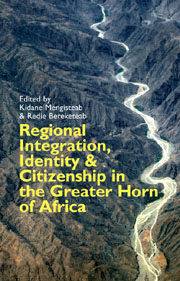Book contents
- Frontmatter
- Contents
- List of Tables, Figures & Appendices
- Notes on Contributors
- Acknowledgements
- List of Acronyms
- Part One RELEVANCE OF INTEGRATION TO IDENTITY AND CITIZENSHIP
- Part Two CRITICAL FACTORS IN INTEGRATION
- 4 Invisible Integration in the Greater Horn Region
- 5 Nationalist, Sub-nationalist, and Region-wide Narratives and the Quest for Integration-promoting Narratives in the Greater Horn Region
- 6 Infusion of Citizenship, Diversity and Tolerance in the Education Curriculum: Promoting Regional Integration and Peace in the Greater Horn Region
- 7 Radio and the Propagation of Anti- and Pro-Ethiopian Narratives in Somalia
- Part Three LESSONS FROM SELECTED AFRICAN INTEGRATION SCHEMES
- Index
- EASTERN AFRICAN STUDIES
6 - Infusion of Citizenship, Diversity and Tolerance in the Education Curriculum: Promoting Regional Integration and Peace in the Greater Horn Region
from Part Two - CRITICAL FACTORS IN INTEGRATION
Published online by Cambridge University Press: 05 February 2013
- Frontmatter
- Contents
- List of Tables, Figures & Appendices
- Notes on Contributors
- Acknowledgements
- List of Acronyms
- Part One RELEVANCE OF INTEGRATION TO IDENTITY AND CITIZENSHIP
- Part Two CRITICAL FACTORS IN INTEGRATION
- 4 Invisible Integration in the Greater Horn Region
- 5 Nationalist, Sub-nationalist, and Region-wide Narratives and the Quest for Integration-promoting Narratives in the Greater Horn Region
- 6 Infusion of Citizenship, Diversity and Tolerance in the Education Curriculum: Promoting Regional Integration and Peace in the Greater Horn Region
- 7 Radio and the Propagation of Anti- and Pro-Ethiopian Narratives in Somalia
- Part Three LESSONS FROM SELECTED AFRICAN INTEGRATION SCHEMES
- Index
- EASTERN AFRICAN STUDIES
Summary
INTRODUCTION
The last five decades have been a significant time of challenge and change for many countries in Africa, and especially in the Horn. Most African countries gained independence from Western colonial powers, with territorial boundaries of various sizes and shapes. Some of these newly-created countries were too small, others too large or landlocked, and in the process divided various communities and culture areas, and lumped together peoples of diverse cultures who had little or no pre-colonial experience of shared governance. In addition, many countries have since experienced, however briefly, a combination of various forms of self-governance, including parliamentary democracy, military dictatorships, coups that led to civil wars, attempted secession, and the like.
Since gaining independence, several countries have begun or are contemplating journeys of transformation to move away from dictatorships, oppressive regimes and violent conflict to participatory democracy, free and fair elections and human rights, while others remain engulfed in internal civil strife and statelessness. The ongoing crises in many parts of Africa and particularly in the Greater Horn Region (GHR) suggest that colonial boundaries have not laid out a stable basis for nationhood, peaceful co-existence and regional harmony. Institutional reform agenda driven from the top via state policies did not thus far produce meaningful change in real life experiences of citizens, be it social, economic or political.
On the contrary, some state policies have directly contributed to the exacerbation of ethnic conflict and competition for scarce resources and power among various culture groups beset by natural disasters such as drought, shortage of water and conditions generally unfavourable for human survival (Lyons, 2006).
- Type
- Chapter
- Information
- Publisher: Boydell & BrewerPrint publication year: 2012

